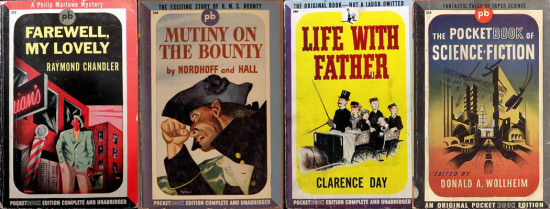We all love our e-readers, our iPads, Kindles and Nooks. They allow us to carry entire libraries worth of books in our pockets, and when we get tired of reading, we can use them to check out Facebook or play Angry Birds.
But July 30 is Paperback Book Day, a holiday that helps us celebrate the previous revolution in book publishing and revel in the sensory delight of the paperback book. After all, you can’t “dog ear” a page of an electric novel. An e-book doesn’t give you that jolt of delight you once got when you saw the paperback cover of your favorite author’s latest novel sitting on the shelf at the drugstore, waiting to be snatched up. And electronic books don’t fill your room with that wonderful, vaguely musty aroma that wafted from your bookshelves, telling you that in the yellowing pages of your favorite paperback, your most treasured stories were waiting to be told again and again.
Paperback books may be going the way of the transistor radio, but for countless millions of readers around the world, they represented an inexpensive way to access both new and classic literature. They brought reading to the masses, they brought about a rise in genres seldom read before, and they changed the way books were made and sold.
The first paperback book was published in England in 1935. Publisher Alan Lane was in a British train station, looking for something to read. All he could find were magazines and junky “pulp fiction.” An idea struck him: what if readers could buy quality books at reasonable prices—maybe for the price of a pack of cigarettes?
Using his own money, Lane started his own publishing house. He called it Penguin Books, and he bought the rights to 10 serious literary titles, including A Farewell to Arms by Ernest Hemingway and Andre Maurois’ Ariel. The books bore simple covers, color-coded for genre (biographies were blue, fiction was orange). Retailing giant Woolworth’s placed an order for more than 63,000 copies. Lane realized he was on to something, and within a year Penguin had sold more than three million books.
 Across the Atlantic, publisher Robert de Graff founded Pocket Books, and released the company’s first title, The Good Earth by Pearl Buck. Pocket Book covers, unlike Penguin’s, were adorned with lavish covers and were sold through distribution networks traditionally used by magazines. Soon, paperback books began popping up in grocery stores, magazine stands and drugstores.
Across the Atlantic, publisher Robert de Graff founded Pocket Books, and released the company’s first title, The Good Earth by Pearl Buck. Pocket Book covers, unlike Penguin’s, were adorned with lavish covers and were sold through distribution networks traditionally used by magazines. Soon, paperback books began popping up in grocery stores, magazine stands and drugstores.
The effect paperback books had on the reading public was profound. Up until this time, there were only about 500 bookstores in the United States, most of them bunched up in the nation’s 12 biggest cities. They sold only hardcover books, many of which cost the equivalent of $40 in today’s currency. With the advent of mass-market paperback books, though, reading quickly spread to people and places that had never had access to purchasing books before.

Then came World War II. American librarians, aghast at the Nazi’s organized book burnings, gathered books to send to U.S. servicemen and women. Hardcover books, however, were too bulky to carry around in combat. Soon, American book publishers began churning out paperback Armed Services Editions (or ASEs) to send to men and women in uniform. Soldiers considered them to be their prized possessions, carrying them all the way to the front lines.
Paperbacks also changed the way booksellers did business. When a hardcover didn’t sell, it was returned to the publisher. But with paperbacks, booksellers only had to strip and return the covers, with the agreement that they’ll “pulp” (or recycle) the coverless books. (This is why you should never buy coverless paperbacks—if you do, publishers aren’t getting payment for them, and—more importantly—authors aren’t getting their royalties, either.)
Throughout the years, as publishers continued to print more and more paperbacks, the books gave rise to new literary genres, including gritty noir mysteries and serious science fiction. Publishers printed collections of popular comic strips, including Charles M. Schulz’s classic Peanuts and Ernie Bushmiller’s Nancy. Today, as the mass-market paperback gives way to e-books, larger “trade” format paperbacks printed on higher-quality paper continue to sell, reprinting collections of modern comic book series such a Marvel’s Wolverine or DC’s Green Lantern/Green Arrow.
So by all means, enjoy your e-books. But as you do, take a moment to salute the paperback, the medium through which generations of readers around the world were able to buy, own and enjoy books. They were made to be disposable, but they’ve left a permanent place in our hearts.








